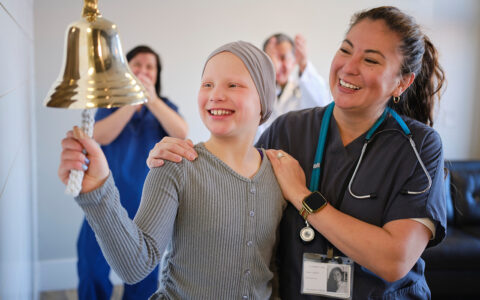Multiple studies have described the detrimental effects of mechanical ventilation on the developing preterm infant, and pediatric hospitals have taken notice. As alternative methods of respiratory support for preterm infants were studied, the trend in non-invasive ventilation grew, according to an analysis published in JAMA Pediatrics.
Understanding the magnitude of these changes informs research and has implications for decisions surrounding newborn intensive care that neonatologists make every day, says first author Dupree Hatch, M.D., medical director of the NICU at Monroe Carell Jr. Children’s Hospital at Vanderbilt.
Together with Stephen Patrick, M.D., director of the Center for Child Health Policy at Vanderbilt, Hatch and a team of researchers found that use of invasive mechanical versus non-invasive ventilation changed significantly in the United States in preterm infants from 2008 through 2018.
“Over that decade, several large trials were published that really changed our neonatal ventilation practices at Vanderbilt and at many other centers across the world,” Hatch said. “Our question was how, specifically, have these practices changed in centers in the United States and what did those changes mean to resource utilization at a national level?”
Systemic Damage From Mechanical Ventilation
Invasive mechanical ventilation can have detrimental effects on the developing brain, Hatch noted, adding that these negative effects can extend to the lungs and other organs, as well.
He says that any form of forced ventilation carries some risks, but studies of respiratory support in preterm infants have consistently shown that when possible, non-invasive ventilation can be safer for infants.
“There is a nuanced way our bodies adapt to prevent our lungs from becoming injured during spontaneous breathing,” Hatch said. “With mechanical ventilation, these can be overridden. Inflammation can be triggered as well and there are probably many micro-injuries happening in the lung that lead to changes across the entire body.”
“There is a nuanced way our bodies adapt to prevent our lungs from becoming injured during spontaneous breathing. With mechanical ventilation, these can be overridden.”
High-Powered Study Speaks Volumes
Hatch and colleagues studied clinical data from preterm infants born at 23 weeks gestational age or later who received respiratory support through either mechanical ventilation or a non-invasive ventilation modality. The latter included nasal intermittent positive-pressure ventilation, continuous positive airway pressure, or high flow nasal cannula.
“Infants born at 23 to 24 weeks were a particularly important group to include,” Hatch said. “Very little observational data exists on practice patterns in these infants at a national level, and more and more of these babies are surviving today than even a decade ago.”
The researchers used two national databases: one from the Agency for Healthcare Research and Quality that represented records of 1,169,441 infants and a more detailed database of 259,311 infants in 359 NICUs supplied by Pediatrix Medical Group.
“To me, the novelty of this study was the ability to marry the more granular data from the smaller database with ICD-9 and 10 codes for mechanical ventilation in the larger national database,” Hatch said. “Together, we were able to make some inferences about total resource utilization in preterm infants in the United States over more than a decade.”
Statistics on Ventilation Compiled
In the Pediatrix database, the percentage of preterm infants receiving mechanical ventilation dropped from 29.4 in 2008 to 18.5 in 2018, and in the larger national database it fell from 22 to 18.5 percent.
“This adds up to nearly 30,000 fewer infants who avoided mechanical ventilation due to changes in practice patterns over the 11-year period, “Hatch said.
“Nearly 30,000 fewer infants avoided mechanical ventilation due to changes in practice patterns over the 11-year period.”
The corollary to this drop was an increase in the number of babies who received non-invasive ventilation in the Pediatrix database, increasing from 57.9 percent to 67.4 percent. The duration of positive-pressure respiratory support of any kind rose by an average of 1.6 days overall, but days on non-invasive ventilation accounted for nearly all of this, rising by 3.2 days in this database. This trend was true across nearly all the gestational ages.
Transitions In Critical Care
Hatch says that the biggest factor influencing these findings may be the growth in knowledge and development of non-invasive options to mechanical ventilators.
“Every day a baby is on a ventilator, their odds of having a poorer neurodevelopmental or cognitive outcome go up. In the future, we want to study the effect of this shift toward non-invasive ventilation over time.”
Vanderbilt, a leading center for the study of how mechanical ventilation and ICU stays impact cognition and mental health, started changing their practices at Monroe Carell when studies demonstrating the optimal strategies for non-invasive ventilation were first published. They were not alone.
“Almost to the month that those trials were released, we started to see mechanical ventilation decline in our national dataset, a testament to how rapidly clinicians in our field adapted to the new evidence,” Hatch said.
He and his team are now looking at these same datasets to try to identify the characteristics of centers that had the most rapid uptake and sustainment in non-invasive ventilation.
“While there were early comers, there was a lot of variation among centers,” Hatch said. “We want to know if there are practices we can glean from the high-performers that could help more centers make the transition.”






